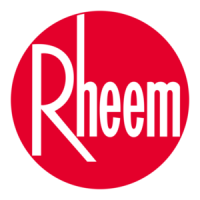What to do if burner flames are distorted in Rheem RGRA?
- JJohn SimmonsAug 8, 2025
If the burner flames in your Rheem Furnace are distorted, inspect the vent and inlet air system for any obstructions that might be causing back pressure.

What to do if burner flames are distorted in Rheem RGRA?
If the burner flames in your Rheem Furnace are distorted, inspect the vent and inlet air system for any obstructions that might be causing back pressure.
How to deal with obstructed air supply registers and return air grilles in Rheem RGRA Furnace?
To optimize the performance of your Rheem Furnace, make sure furniture and drapes do not block the supply air registers and return air grilles.
Why should doors and windows be closed when using Rheem RGRA?
To help your Rheem Furnace operate efficiently, close doors and windows to reduce the heating load on the system.
What to do if my Rheem RGRA is overheating due to dust?
If your Rheem Furnace is overheating due to dust and dirt accumulation on the windings or the motor exterior, the blower motor and induced draft blower motor must be cleaned periodically by a qualified installer, service agency, or the gas supplier.
| Efficiency | Up to 96% AFUE |
|---|---|
| Type | Gas Furnace |
| Ignition System | Direct Spark Ignition |
| Installation Options | Upflow, Downflow, Horizontal |
| Fuel Type | Natural Gas or Propane |
| Configuration | Multi-Position |
| Ignition | Direct Spark |
| Heat Exchanger | Stainless Steel |
| Vent Type | PVC |
| Warranty | Limited Lifetime Heat Exchanger, 10-Year Parts |
| Stages | Single or Two-Stage |
Crucial safety warnings, precautions, and general safety information for furnace installation and operation.
A comprehensive checklist covering gas supply, electrical, furnace, and venting requirements.
Overview of RGRA/RGRJ/RGTA/RGTJ series, relevant codes, and industry standards.
Guidelines for furnace placement, clearances, and considerations for unconditioned spaces.
Requirements for service accessibility and clearances to combustible materials for safe installation.
Factors to consider when selecting the furnace site, including duct and gas piping proximity.
Proper airflow, duct sizing, and connection procedures for upflow and downflow units.
Procedures for venting, combustion air supply, safety switches, and existing vent systems.
Detailed steps for cementing PVC pipes and fittings, including safety warnings.
Requirements for adequate combustion and ventilation air for non-direct furnace installations.
Specific requirements for the combustion air intake system in direct vent furnace installations.
Rules and limitations for non-direct vent pipe installation, including length and elbow requirements.
Clearances and placement criteria for non-direct vent terminals to ensure safety and prevent nuisances.
Installation procedures for direct vent systems, including pipe length, elbows, and termination tables.
Specific piping requirements for combustion air and exhaust in direct vent furnace applications.
Placement and clearance rules for horizontal direct vent terminals to prevent condensate issues.
Instructions and recommendations for venting two or more furnaces, emphasizing individual venting.
Procedures for connecting vent and combustion air pipes to the furnace for upflow and downflow models.
Instructions for setting up condensate drains, using neutralizers, and preventing overflows.
Procedures for reconfiguring the condensate trap for alternative drainage sides on upflow/downflow units.
Detailed steps for converting the condensate trap assembly for horizontal furnace installation.
Requirements for connecting the gas supply, piping, shut-off valves, and drip legs.
Methods for measuring and adjusting supply and manifold gas pressures for optimal furnace input.
Steps for converting the furnace to LP gas, including orifice changes and required labeling.
Procedures for setting and verifying manifold gas pressure for both natural gas and LP gas.
Guidelines for safe electrical wiring, proper grounding, and component connections.
Information on thermostat compatibility and proper low voltage wiring size and connections.
Details on field-installed accessories and procedures for twinning furnace units.
Step-by-step guide for starting the furnace, including sequence of operations and safety checks.
Method for measuring and adjusting furnace gas input rate using meter time and pressure.
Procedure for checking air flow correctness by measuring temperature rise across the furnace.
How to adjust blower speeds and set off-timings for heating, cooling, and fan operation.
Guidelines for cleaning, replacing, and resizing furnace filters for optimal performance.
Recommendations for annual inspections, system operation advice, and troubleshooting references.
Flowcharts for diagnosing issues with Honeywell S9201E2001 or UTEC 1012-920 control boards.
Flowcharts for diagnosing issues with UTEC 1028-927 or Johnson Controls G961DAJ-2401 control boards.
Detailed wiring diagram for RGRA/RGTA models with Honeywell or UTEC 1012-920 control boards.
Wiring diagram for RGRA/RGTA models with UTEC 1028-927 or Johnson Controls G961DAJ-2401 boards.
Wiring diagram for RGRJ/RGTJ models with UTEC 1012-925 control boards and HSI.
